|
|
Obelisks in National Archaeological Museum of Naples
| Present Site: | Obelisk in National Archaeological Museum of Naples, Italy N 40°51'12.9"(40.853582) E 14°15'01.9"(14.250525) |
| 1. (so-called) Palestrina Obelisk | |
| Builder: | Titus Sextius Africanus (Nobleman of Ancient Rome) (1st Century) |
| Size & Material: | 1.9 meters high (Current status in the Museum), Red granite |
| 2. Fragment of Montecitorio Obelisk | |
| 3. Fragment of Lateran Obelisk |
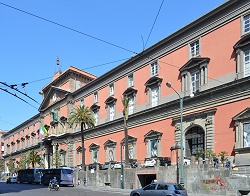 Figure 1: National Archaeological Museum of Naples
Figure 1: National Archaeological Museum of Naples
|
About The Site:
The National Archaeological Museum of Naples (Il Museo Archeologico Nazionale di Napoli) (Figure 1) mainly exhibits the Greek and Roman Arts (collection of Farnese Family) and the fresco painting and mosaic excavated from Pompeii Ruins. The Museum also exhibits the Egyptian Antiques mainly from the collection of Stefano Borgia, Cardinal in 18th Century. Among the huge collections, the mosaic excavated from Pompeii which illustrates Alexander the Great battling Darius III at the Battle of Issus (Figure 2) is best known in this Museum. Among the collections of many ancient coins, I found two (2) Sestertius brass coins of Ancient Roman Empire (Figures 3 & 4).
I was excited with two coins which illustrates the current Flaminio Obelisk standing in Circo Massimo. We often see the lithograph of the obelisk in Circo Massimo, but all of them were illustrated in the Middle Age. But these coins were minted just in the same era when the obelisk was standing in Circo Massimo.
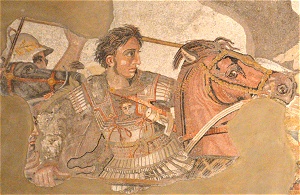 Figure 2: Mosaic illustrates Alexander the Great
Figure 2: Mosaic illustrates Alexander the Great
|
The exhibition rooms of Egyptian antiques had been closed for a long time since 2010. And, it was re-opend on October, 2016. The Egyptian Exhibition Rooms are located in the basement floor. We should obtain the floor plan when we go there because it's hard to find the stairway which accesses to the basement.
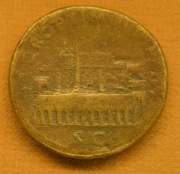 Figure 3: Sestertius brass coin
Figure 3: Sestertius brass coinEmperor Trajanus (103-111) 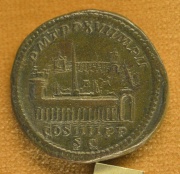 Figure 4: Sestertius brass coin
Figure 4: Sestertius brass coinEmperor Caracalla (213) |
How To Get There:
The Museum is located about 1.2 km, which is not far even if we walk. However, using a subway #1 Line, from Garibaldi (Station) connected to the Central Station (Stazione di Napoli Centrale), is convenient. Although the subway line is a detour, the 6th stop, Museo (Station) connects directly to the Museum. We will never lose a way.
Alternatively, we may use a subway #2 Line, from Garibaldi (Station), go to the 2nd stop, Piazza Cavour (Station), and then walk about 300 meters. This may be faster than above.
Admission fee is € 6.5, under 18 and above 65 are free. Closed every Tuesday.
About The Obelisk:
The National Archaeological Museum of Naples exhibits three (3) obelisks: One is the Obelisk which was made in Roman Empire Era byTitus Sextius Africanus, and rest of two are the fragments of Egyptian Obelisks.
1. Palestrina Obelisk (Fragments)
According to the explanation by the Museum, these fragments were "found in 1791 and published by Zoëga in 1797".
This book would be "De origine et usu obeliscorum" which was published in 1797 by George Zoëga, Danish scholar. This seems to be a classic great book, but I haven't read it yet since it's written in Latin language.
The explanation also says; "Two other fragments were found in 1881". "It was found in the town of Palestrina (Praeneste)". The town is located about 35 km east of Rome. Therefore, the Museum exhibits it by the name of "Palestrina Obelisk".
In Palestrina, the Temple of Isis-Foutuna had once existed, and at present the National Archaeological Museum of Palestrina is on the site. These two fragments can be seen in Wikimedia Commons.
The explanation also says; "Africanus erected its twin in Rome. This second obelisk is presently in the Museum of Egyptian Art in Munich." Comparing the photo which I took it when I visited the State Museum of Egyptian Art in Munich in April 2016, I can deternine these two (Naples and Munich) obelisks seem to be a pair, although both have not the same sentences, but I could confirm many similar points. Also, I can deternine the Fragments in the Palestrina National Archeological Museum are the parts of this Palestrina Obelisk (in Naples here), according to the characterinstics of inscription.
Titus Sextius Africanus became the suffect consul in AD 59. Perhaps this time around this obelisk was made. But we should pay attention on the location where the Obelisk was erected. The Munich Museum says; "original location is unknown". The Naples Museumsays: "erected in Rome". Both don't mention "in Palestrina" as the location where the fragments of obelisk was found.
These fragments in this Museum (Figure 5) are exhibited with a part of four pieces joined together. According to the Guidebook of the Museum, its height is 1.9 m, the width is 46 cm at the thickest part. The width of Obelisk in Munich Museum is about 60 cm. Hence these two obelisks were not the pair, I suppose, even they were made in the same time period.
Judging from the illustration in Figure 6, what is exhibited in this Naples Museum is the lower part of the obelisk. The face in Figure 5 corresponds to the second one from left in Figure 6. Also two fragments of above and center in the illustration of Figure 6, the inscriptions correspond to the ones in the Palestrina Museum.
|
||||
May 8, 2017 by Hiroyuki Nagase (For high definition image, please click the picture)
| ||||
2. Fragment of Montecitorio Obelisk
Figure 7 is the one which is exhibited as the "Fragment of Montecitorio Obelisk". The Museum's Guidebook says: 2.15 m in hight, 63 cm in width, and 12 cm in thickness.
Please refer to Montecitorio Obelisk for the details on the Montecitorio Obelisk.
Montecitorio Obelisk (in Rome) is, the lower portion is lost and restored with other stone material. Even on the south side where there are relatively many original parts remain, about 1/4 of the lower portion is repaired. For this reason, it is unknown where this fragment fits. Also, although the Montecitorio Obelisk is severely damaged, the inscription carving is deep and the outline is clear where the original part remains. but this fragment (in this Museum) seems to be considerably worn. Therefore, we cannot see this is a part of Montecitorio Obelisk unless the explanation is done.
I imagine that the Montecitorio Obelisk was buried in the ground after collapse, but this fragment might have exposed to the weather on the ground.
3. Fragment of Lateran Obelisk
The headline of the explantion of this Museum (Figure 13) says "Lower fragment of obelisk with the name of Ramesses II" However, the obelisk must be the "Lateran Obelisk", which was erected by Thutmose III and IV.
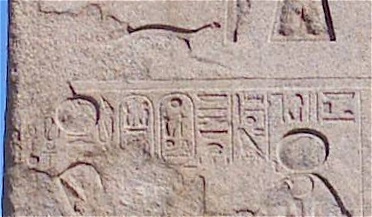 Figure 10: The lowest portion of the south side of Lateran Obelisk
Figure 10: The lowest portion of the south side of Lateran ObeliskFrom my pictire collection |
Lateran Obelisk in Rome (Figure 12), the lowest portions of south and west sides remain, but east and north sides are supplemented with a pattern like a quite ambiguos inscription drawn on the other stone material. Hense, this fragment would probably be the right side of the lowest portion of north side, or the lowest portion of east side, I suppose.
In the meantime, as the explanation says, the birth name (right line) and the coronation name (left line) of Ramesses II are inscribed in this fragment. I knew the names of Thutmose III and IV are inscribed, but I wasn't aware of the name of Ramesses II exists. After serching various literatures, finally I found that the name of Ramesses II appears in the book "THE TWELVE EGYPTIAN OBELISKS IN ROME" (by John Henry Paker), published in 1879 in Britain. This is on page 14, the article "At the base". Then I checked all the pictures I have taken in the past, and I found the spot that the name of Ramesses II, his coronation name and the upper half of the birth name in my picture (Figure 10) of the lowest portion of the south side of Lateran Obelisk, which was taken on August 11, 2013.
Notes For Pictures:
I felt the explanation of the Egyptian Exhibition Room at The National Archaeological Museum of Naples is very kind. For example, even only the sentence of "Lower fragment of obelisk with the name of Ramesses II" would be the average level of the Museums in the world. But in this Museum, it gives us a deeper explanation, say it's a twin of Munich's Obelisk, it's a fragment of Montecitorio Obelisk, it's a fragment of Lateran Obelisk. Although it's a simple and casual explanation, but I was impressed with the explanation written based on the research. Since the exhibits other than the Obelisk are also very fulfilling, I definitely want you to reach The National Archaeological Museum of Naples when you have a chance to visit Italy.
Copyright Hiroyuki Nagase nagase@obelisks.org and Shoji Okamoto okamoto@obelisks.org